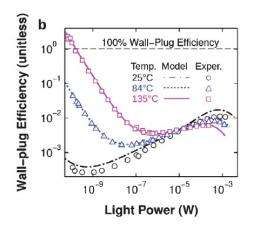March 5, 2012 report
LED's efficiency exceeds 100%
Lisa Zyga
contributing writer

(�鶹��ԺOrg.com) -- For the first time, researchers have demonstrated that an LED can emit more optical power than the electrical power it consumes. Although scientifically intriguing, the results won’t immediately result in ultra-efficient commercial LEDs since the demonstration works only for LEDs with very low input power that produce very small amounts of light.
The researchers, Parthiban Santhanam and coauthors from MIT, have published their study in a recent issue of �鶹��Ժical Review Letters.
As the researchers explain in their study, the key to achieving a power conversion efficiency above 100%, i.e., “unity efficiency,” is to greatly decrease the applied voltage. According to their calculations, as the voltage is halved, the input power is decreased by a factor of 4, while the emitted light power scales linearly with voltage so that it’s also only halved. In other words, an LED’s efficiency increases as its output power decreases. (The inverse of this relationship - that LED efficiency decreases as its output power increases - is one of the biggest hurdles in designing bright, efficient LED lights.)
In their experiments, the researchers reduced the LED’s input power to just 30 picowatts and measured an output of 69 picowatts of light - an efficiency of 230%. The physical mechanisms worked the same as with any LED: when excited by the applied voltage, electrons and holes have a certain probability of generating photons. The researchers didn’t try to increase this probability, as some previous research has focused on, but instead took advantage of small amounts of excess heat to emit more power than consumed. This heat arises from vibrations in the device’s atomic lattice, which occur due to entropy.
This light-emitting process cools the LED slightly, making it operate similar to a thermoelectric cooler. Although the cooling is insufficient to provide practical cooling at room temperature, it could potentially be used for designing lights that don’t generate heat. When used as a heat pump, the device might be useful for solid-state cooling applications or even power generation.
Theoretically, this low-voltage strategy allows for an arbitrarily efficient generation of photons at low voltages. For this reason, the researchers hope that the technique could offer a new way to test the limits of energy-efficiency electromagnetic communication.
Written for you by our author —this article is the result of careful human work. We rely on readers like you to keep independent science journalism alive. If this reporting matters to you, please consider a (especially monthly). You'll get an ad-free account as a thank-you.
More information:
Parthiban Santhanam, et al. “Thermoelectrically Pumped Light-Emitting Diodes Operating above Unity Efficiency.” �鶹��Ժ. Rev. Lett. 108, 097403 (2012). DOI:
Journal information: �鶹��Ժical Review Letters
© 2011 �鶹��ԺOrg.com

















